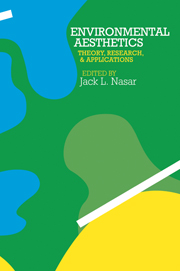Editor's introduction
Published online by Cambridge University Press: 05 September 2013
Summary
Two landmark studies in both environmental aesthetics and environmental psychology are the Maslow and Mintz (1956) and Mintz (1956) comparisons of exposure to “beautiful,” “neutral,” and “ugly” rooms. The studies ostensibly found short-term and long-term effects related to aesthetics. In the first paper in this section, Locasso turns a critical eye to potential method artifacts in these studies. He replicated the “short-term” study with controls to overcome these artifacts, and he found little evidence of direct short-term effects of the aesthetic manipulation. Does this mean that aesthetic quality has no effect? No. Taken together, the findings of Maslow and Mintz and Locasso suggest that although short-term exposure to various aesthetic conditions per se may not affect behavior, the effects are likely to occur through the interaction of visual quality with social factors and long-term experience. Thus it is important to understand the nature of environmental aesthetics.
One line of research has aimed at deriving adjective scales relevant to the description of the physical surroundings. Such scales are of value to the researcher interested in the nature of aesthetic response, the designer interested in establishing user or client design preferences, or others interested in evaluating their own surroundings. Central to this line of research is the second paper in this section, in which Kasmar describes several studies that identify sixty-six bipolar adjectives that the public and designers commonly use in describing architectural interiors.
Information
- Type
- Chapter
- Information
- Environmental AestheticsTheory, Research, and Application, pp. 133Publisher: Cambridge University PressPrint publication year: 1988
